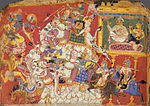Bhagadatta
| Part of a series on the |
| Mythology of Pragjyotisha |
|---|
 |
| Ruling dynasties |
| Bhagadatta | |
|---|---|
 Arjuna shoots Bhagadatta. | |
| Information | |
| Family | Narakasura (Father) |
| Children | Vajradatta and Pushpadatta (sons) |
Bhagadatta was the mythical son of Narakasura, king of the Pragjyotisha Kingdom and second in line of kings of Naraka dynasty.[1] He was succeeded by his son Vajradatta.[2] He fought for the Kaurava in the Mahabharata war as he was an enemy of Lord Krishna. He was the leader of a great army of Kiratas and Chinas in the war.[3]
Life in mythology[]
In the Battle of Kurukshetra, Bhagadatta fought on the side of the Kauravas. He was very well known for his skill on his elephant. On the 12th day of the war, he was involved in a fierce battle with Arjuna on his World Elephant Supratika, who was being attacked by Bhima. During the course of this battle, Bhagadatta fired the super-weapon on Arjuna.[4] Before Arjuna could counter this weapon, however, Krishna intervened by standing up at the Charioteers position. Krishna let His Chest to be a cushion for His potent weapon, which turned into a garland and fell on Krishna (a weapon given to Bhagadatta by Lord Vishnu finally returned to his avatar). Bhagadatta was killed by a lethal arrow shot into his chest by Arjuna.[5][6][7]
In Kalika Purana, Harshacharita, Puranas and in other epics; Naraka is said to have sons namely Bhagadatta, Mahasirsa, Madavan and Sumali. Vajradatta and Pushpadatta are sons of Bhagadatta.
See also[]
- Kamarupa kingdom
Notes[]
- ^ "The Myth Connect | Outlook India Magazine". outlookindia.com/. Retrieved 9 July 2020.
- ^ (Sircar 1990, p. 81)
- ^ Chatterji 1974, p. 32.
- ^ Menon, Ramesh (2006) The Mahabharata: A Modern Rendering iUniverse, Inc., New York, page 231-232, ISBN 978-0-595-40187-1
- ^ "Bhagadatta - King of Pragjyotisha - Indian Mythology". Archived from the original on 28 August 2005.
- ^ "The Mahābhārata, Book 6: Bhishma Parva: Bhagavat-Gita Parva: Section LXIV".
- ^ Gopal, Madan (1990). K.S. Gautam (ed.). India through the ages. Publication Division, Ministry of Information and Broadcasting, Government of India. p. 75.
References[]
- Chatterji, S. K. (1974). Kirata-Jana-Krti. Calcutta: The Asiatic Society.
- Characters in the Mahabharata
- Pragjyotisha Kingdom
- Hindu mythology stubs
